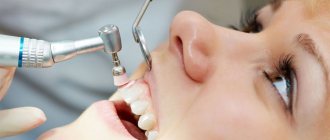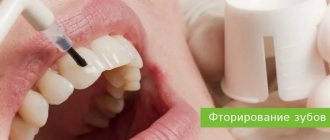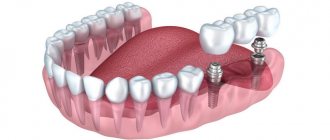Teeth have a special coating called enamel. It performs a protective function, protecting soft parts from the penetration of bacteria into them, and also prevents the possibility of mechanical damage. With improper dental care, a process called demineralization develops. It represents a decrease in the amount of essential salts and minerals in the enamel, which ultimately leads to disruption of its structure. To prevent the occurrence of negative consequences from this process, dentistry has a special procedure - remineralization of teeth. With its help, it is possible to restore thinned enamel, which is successfully implemented only in the initial stages of the development of pathology.
Remineralization of teeth - what is this process?
The porosity of the enamel allows the free passage of acids into the enamel layer, which leads to the leaching of useful minerals. This is a normal process that occurs continuously in a healthy body. Minerals washed out by acids are replenished with new elements, which ensures the maintenance of the optimal composition of the enamel.
If the acid-base balance is disturbed, then the development of the demineralization process is observed. The amount of minerals washed out by acids is actively decreasing, and their composition is not replenished. The procedure for remineralization of teeth is carried out to restore the quality of tooth enamel, that is, the missing amount of mineral substances is replenished.
Symptoms of dental demineralization
The main symptoms of demineralization include:
- loss of wet shine in enamel;
- roughness on the surfaces of teeth;
- the appearance of dull spots on the teeth;
- coloring matte spots with food pigments or dyes;
- fragility (porosity) of enamel.
Demineralization in an adult: photo
Causes of demineralization
Acids entering the oral cavity contribute to the leaching of beneficial minerals, which leads to the development of the demineralization process. However, after eating food in a healthy body, their quantity is restored. If malfunctions occur in the human body, for example, plaque forms on the teeth due to insufficient care, then the acidity balance is disturbed, which entails the development of pathology. The most common causes of the process of demineralization of tooth enamel include the following:
- Hygiene is not maintained - teeth brushing should be done 2 times a day, and its duration should be at least 2 minutes. After eating food, it is recommended to rinse the mouth with special preparations or plain water.
- Nutritional imbalance - if the diet contains a lot of carbohydrates and there is an insufficient supply of minerals.
- Consuming a large number of acid-containing foods, which include not only citrus fruits, but also various carbonated drinks.
- Metabolic disorders or hormonal imbalances in the body that occur against the background of various factors: pregnancy, stress, adolescence, etc.
- Bad habits - in particular, smoking contributes to the active development of the demineralization process.
- Bleaching of enamel, which ultimately can also lead to the leaching of mineral substances and, as a result, cause the development of pathology. This procedure must be carried out by an experienced professional, and after it is performed, the patient must follow strict hygiene rules.
- Wearing dentures and braces - failure to follow the rules of care leads to damage to the enamel.
In order to detect dental diseases in a timely manner, you only need to regularly visit the dental office for preventive examinations.
Prevention of demineralization
To prevent demineralization at home, you should first take care of proper nutrition. The diet should include foods rich in fluoride, calcium and other substances that are beneficial for tooth enamel. These include:
- Legumes;
- Green vegetables;
- Milk and dairy products;
- Nuts.
In addition, it is recommended to reduce consumption or completely eliminate tea, coffee, carbonated drinks, and sugar from the diet.
A course of home remediation involves the use of special products aimed at restoring the mineral composition of tooth enamel. Retherapy gels will help provide this effect. For example, the following are well suited for these purposes:
- GC Tooth Mousse;
- Dental Resources (USA);
- ROCS Medicals Minerals.
To achieve maximum effect, it is better to fill the mouthguards with the listed gels. This way the composition does not come into contact with saliva and adheres to the enamel as tightly as possible. It is better to make custom-made mouthguards so that they accurately replicate the anatomical structure of the teeth.
Don't forget about proper oral care. In this case, irrigators will be indispensable. These are effective tools that remove food particles using a targeted jet of water. As a result, the mechanical impact on tooth enamel is reduced, so even people with hypersensitive teeth can use irrigators.
At the same time, we should not forget that preventive care products for demineralization of teeth should be selected by the attending physician. You should also contact your dentist if you experience any discomfort that occurs during tooth enamel retherapy.
Author of the article
The remineralization process: how it is carried out
Remineralization allows you to restore the quality of enamel by filling it with important trace elements. In this case, hard tissues are strengthened. Due to all this, the sensitivity of teeth (to cold, hot) is ultimately reduced, and the likelihood of developing caries will be much lower.
A professional procedure is carried out by treating teeth with special preparations that contain the necessary mineral components: usually calcium, magnesium, phosphorus, fluorine. They are left on the teeth for several minutes until the enamel is completely saturated. The technique includes the following steps:
- Teeth cleaning.
- Treat them with a 1% hydrogen peroxide solution, followed by drying.
- Applying tampons with a 10% solution of calcium gluconate, which are applied for 20 minutes and changed every 5 minutes.
- The final stage is an application of sodium fluoride for 5 minutes.
Important! Sometimes electrophoresis is used to speed up the remineralization procedure.
Treatment involves completing an appropriate course (15-20 sessions), since one procedure does not achieve the desired result. In order to avoid the recurrence of problems with the development of pathology in the future, you need to regularly visit the dentist and, if necessary, immediately restore the thinned layer of tooth enamel.
Treatment of enamel demineralization
Remineralization is the opposite process of demineralization. It can be natural and artificial. We talked about natural remineralization above. It comes down to replenishing missing minerals with food.
As for remineralization in dentistry, such therapy is carried out in several stages:
- professional teeth cleaning;
- drying the enamel with a stream of warm air;
- treatment of enamel with preparations with a high concentration of minerals, in particular calcium salts;
- fluoridation of teeth - application of preparations with sodium fluoride (gels or fluoride varnish are used).
The treatment plan is worked out in advance by the doctor, based on diagnostic data. The number of remineralization sessions is selected separately in each case.
Pros and cons of performing the procedure
If you resort to teeth remineralization in a timely manner, the effect will be maximum. Among the advantages of the procedure:
- Absolute harmlessness, safety and painlessness.
- Quick and reliable restoration of the integrity of the tooth coating (enamel).
- Prevention of the development of oral diseases.
Remotherapy is prescribed not only to adults, but also to children. After all, the condition of the baby teeth determines what the permanent teeth will be like.
There are practically no disadvantages of remineralization. The choice of means depends on the individual characteristics of the body. The effectiveness of the procedure is associated not only with the drugs chosen for its implementation, but also with the correctness of the preparatory work (teeth cleaning and sanitation).
Demineralization of baby teeth in children
Demineralization of teeth is a common occurrence among children. Two factors are decisive here - poor oral hygiene and a passion for sweets.
As a rule, in children and adolescents, demineralization takes the form of irregularly shaped spots. The color of such formations varies from white to brown. Most often, the pathological process in a child begins in the cervical area, then spreading to other areas.
Important. If demineralization spots have acquired a brown color, this indicates an advanced process. In this case, not only the enamel is affected, but also the dentin tissue.
Demineralization of teeth in a child: photo
Indications and contraindications for
Indications for remineralization are the following factors:
- Identifying signs of demineralization.
- Increased sensitivity of teeth to food, hot and cold.
- Plaque on the teeth.
- Sensitivity appears after teeth whitening or tartar removal.
Remineralization is a virtually harmless and safe procedure that has no contraindications. It is prohibited in one case, when the patient has an individual intolerance to the drugs used for therapy.
To keep your teeth healthy, it is important not only to maintain oral hygiene, but also to regularly visit the dental office. This will make it possible to identify diseases in the early stages and prevent their development using simple, safe, reliable and inexpensive procedures.
Symptoms of dental mineralization disorders
How can one suspect that a person has begun the process of demineralization?
The earliest manifestation of demineralization is focal damage to the enamel. In this case, white spots become noticeable on the tooth enamel, which are located on the tooth base or at the junction of two teeth. The stains can be barely noticeable or occupy an entire tooth. Initially, the patient has one or two teeth affected. This pathology occurs especially often in children under 11 years of age. It also occurs in adults, but much less frequently.
At the initial stage, when demineralization is just beginning to break down, it is very difficult to detect.
The main manifestations of enamel pathology at an early stage are:
- decreased shine of teeth;
- acquisition of dullness by teeth.
Then the pathological process intensifies and becomes more pronounced, which is manifested by symptoms:
- streaks or chalky spots on the enamel;
- porosity, roughness and deformation of enamel;
- darkening of white spots on the enamel, subsequently turning brown.
Thinning tooth enamel begins to darken and decay, forming carious lesions on the teeth. And this process cannot end on its own. Therefore, even with minimal suspicion of the onset of enamel destruction, it is important to consult a dentist as soon as possible.
Upcoming events
2021-09-01BASIC COURSE ON DENTAL IMPLANTATION WITH DR. FRIEDMAN FOR STUDENTS AND RESIDENTS (Annual course)
2022-01-26Predictable results of orthopedic treatment in digital format.
2022-02-05International Implantology Congress
Hypoplasia can be systemic (teeth that are formed in one period of time are symmetrically affected) and local (Turner’s teeth). Local hypoplasia is a lesion of one tooth. This happens due to injury to the follicle or due to the spread of the inflammatory process of a temporary tooth to the germ of a permanent one.
Remineralization of teeth in childhood
In children, there are frequent cases of dental demineralization, since the growth and development of the body requires an increased amount of microelements. In children, dental remineralization is used in a clinic or at home.
The use of chemicals to restore tooth enamel is not recommended for children under 5 years of age (except for extremely advanced cases). In this case, medicinal pastes, varnishes or gels are used.
The following remineralization methods are often used for children:
- vitamin and calcium-containing preparations to strengthen enamel, vitamin D, fish oil;
- brushing teeth with special children's toothpastes;
- fluoridation of teeth (also used for children);
- rinsing with special compounds 2-3 times a day;
- enriching the diet with dairy products, fish, meat dishes;
- limiting sweet and sour foods at the slightest suspicion of caries.










